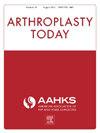C-Reactive Protein as a Predictor of the Success of Debridement, Antibiotics and Implant Retention in Patients With Periprosthetic Joint Infection: A 17-year Retrospective Study of 2 Major Joint Arthroplasty Centers
IF 2.1
Q3 ORTHOPEDICS
引用次数: 0
Abstract
Background
This retrospective study aims to investigate whether C-reactive protein (CRP) value following debridement, antibiotics, and implant retention (DAIR) procedure is a sensitive and specific marker to monitor the clinical course and predict the outcome of the DAIR procedure.
Methods
The electronic clinical management system was used to identify patients who suffered from the first episode of periprosthetic joint infection (PJI) following a total hip or knee arthroplasty and 2) and received DAIR as their first surgical treatment in 2 tertiary hospitals.
Results
Sixty-five patients were included in this study. Mean age was 68.5 and 55.7% were female. Mean follow-up duration was 3.31 years. 42 (64.6%) patients had successful DAIR while 23 (35.4%) had failed DAIR. Statistical analysis was carried out. Patients with PJI within 3 months from initial arthroplasty, infected by organism without drug resistance, and symptom onset within 3 days, and who could achieve a CRP cutoff at 5 mg/dL by 2 weeks, were significantly more likely to have successful DAIR (P = .037). The area under the curve was 0.892 (95% confidence interval: 0.811-1.000). Patients with PJI more than 3 months after the initial operation were 24.9 times more likely to fail DAIR after adjustments (P = .019).
Conclusions
This is the first study to report a CRP cutoff at 5 mg/dL at 2 weeks was able to assist in identifying patients at higher risk of failure following DAIR procedure.
c反应蛋白作为假体周围关节感染患者清创、抗生素和种植体保留成功的预测因子:一项对2个主要关节置换术中心的17年回顾性研究
本回顾性研究旨在探讨清创、抗生素和种植体保留(DAIR)手术后的c反应蛋白(CRP)值是否为监测临床过程和预测DAIR手术结果的敏感和特异性标志物。方法采用电子临床管理系统对2家三级医院全髋关节置换术后首次发生假体周围关节感染(PJI)并首次行DAIR手术的患者进行分析。结果共纳入65例患者。平均年龄68.5岁,女性55.7%。平均随访时间为3.31年。DAIR成功42例(64.6%),失败23例(35.4%)。进行统计分析。在初始关节置换术后3个月内出现PJI,感染无耐药性的生物体,症状在3天内出现,并且在2周内达到5 mg/dL的CRP切断的患者,DAIR成功的可能性更大(P = 0.037)。曲线下面积为0.892(95%置信区间:0.811-1.000)。术后3个月以上PJI患者调整后DAIR失败的可能性为24.9倍(P = 0.019)。这是第一个报道CRP在2周时达到5 mg/dL的临界值能够帮助识别DAIR手术失败风险较高的患者的研究。
本文章由计算机程序翻译,如有差异,请以英文原文为准。
求助全文
约1分钟内获得全文
求助全文
来源期刊

Arthroplasty Today
Medicine-Surgery
CiteScore
2.90
自引率
0.00%
发文量
258
审稿时长
40 weeks
期刊介绍:
Arthroplasty Today is a companion journal to the Journal of Arthroplasty. The journal Arthroplasty Today brings together the clinical and scientific foundations for joint replacement of the hip and knee in an open-access, online format. Arthroplasty Today solicits manuscripts of the highest quality from all areas of scientific endeavor that relate to joint replacement or the treatment of its complications, including those dealing with patient outcomes, economic and policy issues, prosthetic design, biomechanics, biomaterials, and biologic response to arthroplasty. The journal focuses on case reports. It is the purpose of Arthroplasty Today to present material to practicing orthopaedic surgeons that will keep them abreast of developments in the field, prove useful in the care of patients, and aid in understanding the scientific foundation of this subspecialty area of joint replacement. The international members of the Editorial Board provide a worldwide perspective for the journal''s area of interest. Their participation ensures that each issue of Arthroplasty Today provides the reader with timely, peer-reviewed articles of the highest quality.
 求助内容:
求助内容: 应助结果提醒方式:
应助结果提醒方式:


